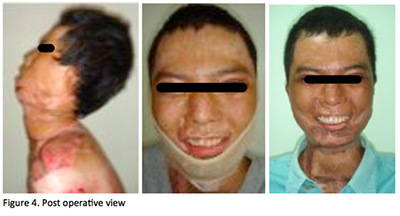Acromiocervical Flap As One of the Modality To Reconstruct Post-Burn Neck Contracture: A Case Report
DOI:
https://doi.org/10.14228/jpr.v1i4.78Abstract
Abstract: Postburn neck contractures are frequent and may cause gross facial deformity and severe functional disability. Reconstruction of these deformities is challenging, especially to plastic surgeon. Several methods have been published including skin graft, local flap and free flap.
Patient and Method: The case presented in this paper is a postburn neck contracture which had been managed by two plastic surgeons in two different hospitals. This deformity limits the normal function of eating, speaking and appearance of this patient. Skin graft was used to correct this deformity but in the next few months neck contracture recurred.
Result: It results in minimal disability and in overall improved functional and appearance outcome. We report our experience using the acromiocervical flap on a case for reconstruction of neck contracture with a goal to prevent recurrence.
Summary: Skin Grafting is not an easy and simple procedure for reconstruction of the neck contracture. It requires comprehensive rehabilitation program including prolonged neck splinting and patient compliance. Considering those difFIculties acromiocervical flap can be one of the modality to reconstruct post burn neck contracture because it is relatively simple and reliable.

Downloads
Published
Issue
Section
License

This work is licensed under a Creative Commons Attribution-NonCommercial-NoDerivatives 4.0 International License.
Authors retain the copyright of the article and grant Jurnal Plastik Rekonstruksi the right of first publication with the work simultaneously licensed under a Creative Commons Attribution License. Articles opting for open access will be immediately available and permanently free for everyone to read, download and share from the time of publication. All open access articles are published under the terms of the Creative Commons Attribution-Non-commercial-NoDerivatives (CC BY-NC-ND) which allows readers to disseminate and reuse the article, as well as share and reuse of the scientific material. It does not permit commercial exploitation or the creation of derivative works without specific permission.













